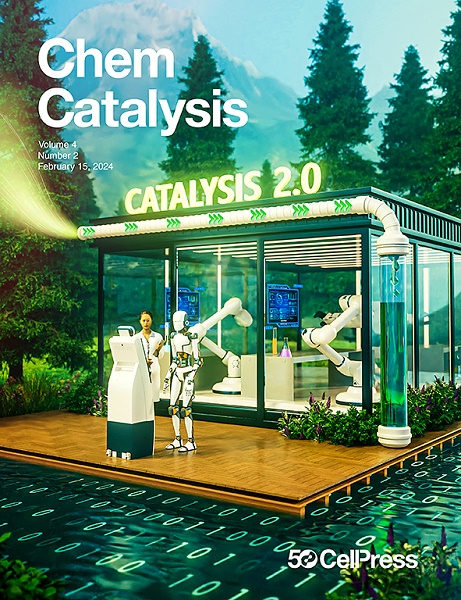用n -杂环碳- ir (III)催化蓝光诱导1,3-二烯的1,4-氨基烷基化
IF 11.6
Q1 CHEMISTRY, PHYSICAL
引用次数: 0
摘要
1,3-二烯的精确烷基化二官能化是合成有价烯丙胺的有效方法。本研究利用新型n -杂环碳(NHC)-Ir(III)配合物作为光催化剂,在可见光诱导下实现了1-取代的1,3-二烯衍生物的1,4-氨基烷基化反应。利用n -羟基邻苯二胺酯作为烷基和氨基前驱体,可以得到各种各样的烯丙基胺,这些胺是目前报道的难以通过其他转化得到的,并且具有良好的收率和区域非对映选择性。广泛的底物范围和独特的1,4-区域选择性为已建立的过渡金属催化1-取代1,3-二烯的3,4-氨基烷基化提供了独特的补充方法;机理研究表明,光催化剂介导的蓝光诱导的烯丙基自由基/阳离子交叉以及邻苯二甲酰单元与芳基底物之间的π-π堆积在区域选择性转化中也起着至关重要的作用,证明了NHC-Ir(III)光催化体系在当前级联烷基层化转化中的优势。本文章由计算机程序翻译,如有差异,请以英文原文为准。

Blue light-induced 1,4-aminoalkylation of 1,3-dienes enabled by N-heterocyclic carbene-Ir(III) catalysis
The precise alkylamination difunctionalization of 1,3-dienes represents an efficient method for synthesizing valuable allylic amines. Here, we present an efficient visible light-induced uncommon 1,4-aminoalkylation of 1-substituted 1,3-diene derivatives by developing novel N-heterocyclic carbene (NHC)-Ir(III) complex as the photocatalyst. Various allylic amines, which are difficult to obtain through other transformations so far reported, can be obtained with good to excellent yields and regio-, diastereoselectivities by using N-hydroxyphthalimide esters as both alkyl and amino precursors. The broad substrate scope and distinct 1,4-regioselectivity offer a unique supplementary approach to the established transition metal-catalyzed 3,4-aminoalkylation of 1-substituted 1,3-dienes; mechanistic studies indicate that blue light-induced allylic radical/cation crossover mediated by the photocatalyst and the π-π stacking between the phthalimidyl unit and the aryl substrates also play a crucial role in the regioselective transformation, demonstrating the superiority of this NHC-Ir(III) photocatalytic system in current cascade alkylamination transformation.
求助全文
通过发布文献求助,成功后即可免费获取论文全文。
去求助
来源期刊
CiteScore
10.50
自引率
6.40%
发文量
0
期刊介绍:
Chem Catalysis is a monthly journal that publishes innovative research on fundamental and applied catalysis, providing a platform for researchers across chemistry, chemical engineering, and related fields. It serves as a premier resource for scientists and engineers in academia and industry, covering heterogeneous, homogeneous, and biocatalysis. Emphasizing transformative methods and technologies, the journal aims to advance understanding, introduce novel catalysts, and connect fundamental insights to real-world applications for societal benefit.

 求助内容:
求助内容: 应助结果提醒方式:
应助结果提醒方式:


